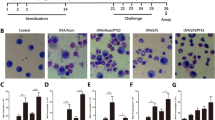Abstract—
Treg/Th17 cell imbalance and inflammatory response may occur in neonatal asthma. IL-35 and BCG have inhibitory effects on inflammatory responses in diseases. However, studies on neonatal asthma after combination of the two have not been reported so far. A respiratory syncytial virus (RSV)–induced neonatal asthma model was first developed in newborn mice. Pathological sections of lung tissue of asthmatic mice were observed by HE staining. Masson staining was used to observe the lung tissue and to compare the deposition of collagen fibers under bronchial epithelium in model mice. The expression of cytokines in serum was detected by ELISA. Giemsa staining analyzed each cell in bronchoalveolar lavage fluid (BALF). Flow cytometry was used to detect the differentiation and development of Treg and Th17 subgroups in BALF. The expression levels of inflammation-related factors were detected by RT-qPCR. Western blot was used to detect the expression of JNK pathway–related proteins. Recombinant IL-35-BCG improved the pathological response of asthmatic mice; inhibited the expression of IgE in serum, neutrophils, macrophages, and eosinophils in BALF; and increased the expression of lymphocytes. In addition, recombinant IL-35-BCG significantly inhibited Th17 differentiation, promoted Treg cell differentiation, and inhibited the expression of inflammatory factors in lung tissue homogenates, thereby reducing allergic airway inflammation. This process might be achieved by inhibiting the JNK signaling pathway. Recombinant IL-35-BCG can regulate Treg/Th17 cell imbalance and inflammatory response in asthmatic newborn mice induced by RSV through JNK signaling pathway, suggesting a new path to neonatal asthma treatment.






Similar content being viewed by others
Availability of Data and Materials
The analyzed data sets generated during the present study are available from the corresponding author on reasonable request.
References
Restori, K.H., B.T. Srinivasa, B.J. Ward, and E.D. Fixman. 2018. Neonatal immunity, respiratory virus infections, and the development of asthma. Frontiers in Immunology 9: 1249.
Huang, L., Y. Bao, Z. Xu, et al. 2013. Neonatal bilirubin levels and childhood asthma in the US Collaborative Perinatal Project, 1959–1965. American Journal of Epidemiology 178: 1691–1697.
Pollock, M., I.P. Sinha, L. Hartling, B.H. Rowe, S. Schreiber, and R.M. Fernandes. 2017. Inhaled short-acting bronchodilators for managing emergency childhood asthma: An overview of reviews. Allergy 72: 183–200.
Garcia-Garcia, M.L., C. Calvo Rey, and Rabes T. Del Rosal. 2016. Pediatric asthma and viral infection. Archivos de Bronconeumologia 52: 269–273.
Krishnamoorthy, N., A. Khare, T.B. Oriss, et al. 2012. Early infection with respiratory syncytial virus impairs regulatory T cell function and increases susceptibility to allergic asthma. Nature Medicine 18: 1525–1530.
Zomer-Kooijker, K., C.K. van der Ent, M.J. Ermers, et al. 2014. Increased risk of wheeze and decreased lung function after respiratory syncytial virus infection. PLoS One 9: e87162.
Qin, L., K. Qiu, C. Hu, L. Wang, G. Wu, and Y. Tan. 2019. Respiratory syncytial virus promoted the differentiation of Th17 cells in airway microenvironment through activation of Notch-1/Delta3. Journal of Medical Microbiology 68: 649–656.
Kim, M.J., D.H. Shim, H.R. Cha, et al. 2019. Chitinase 3-like 1 protein plays a critical role in respiratory syncytial virus-induced airway inflammation. Allergy 74: 685–697.
Rey-Jurado, E., J. Soto, N. Galvez, and A.M. Kalergis. 2017. A safe and efficient BCG vectored vaccine to prevent the disease caused by the human Respiratory Syncytial Virus. Human Vaccines & Immunotherapeutics 13: 2092–2097.
Park, S.S., E.Y. Heo, D.K. Kim, H.S. Chung, and C.H. Lee. 2015. The association of BCG vaccination with atopy and asthma in adults. International Journal of Medical Sciences 12: 668–673.
Liang, P., S. Peng, M. Zhang, Y. Ma, X. Zhen, and H. Li. 2017. Huai Qi Huang corrects the balance of Th1/Th2 and Treg/Th17 in an ovalbumin-induced asthma mouse model. Bioscience reports 37.
Deng, Y., W. Li, Y. Luo, et al. 2014. Inhibition of IFN-gamma promotes anti-asthma effect of Mycobacterium bovis Bacillus Calmette-Guerin neonatal vaccination: A murine asthma model. Vaccine 32: 2070–2078.
Christiaansen, A.F., P.M. Boggiatto, and S.M. Varga. 2014. Limitations of Foxp3(+) Treg depletion following viral infection in DEREG mice. Journal of Immunological Methods 406: 58–65.
Asad, M., A. Sabur, M. Shadab, et al. 2019. EB1-3 Chain of IL-35 Along with TGF-beta synergistically regulate anti-leishmanial immunity. Frontiers in Immunology 10: 616.
Liu, X., H. Hu, H. Fan, et al. 2017. The role of STAT3 and AhR in the differentiation of CD4+ T cells into Th17 and Treg cells. Medicine (Baltimore) 96: e6615.
Liu, W., S. Liu, M. Verma, et al. 2017. Mechanism of TH2/TH17-predominant and neutrophilic TH2/TH17-low subtypes of asthma. Journal of Allergy Clinical Immunology 139: 1548–1558 e1544.
Wacleche, V.S., A. Landay, J.P. Routy, and P. Ancuta. 2017. The Th17 lineage: from barrier surfaces homeostasis to autoimmunity, cancer, and HIV-1 pathogenesis. Viruses 9.
Chae, W.J., A.K. Ehrlich, P.Y. Chan, et al. 2016. The Wnt antagonist Dickkopf-1 promotes pathological type 2 cell-mediated inflammation. Immunity 44: 246–258.
Zhang, Y., S. Li, S. Huang, et al. 2019. IL33/ST2 contributes to airway remodeling via p-JNK MAPK/STAT3 signaling pathway in OVA-induced allergic airway inflammation in mice. Experimental Lung Research 45: 65–75.
Kumar, A., U.K. Singh, S.G. Kini, et al. 2015. JNK pathway signaling: A novel and smarter therapeutic targets for various biological diseases. Future Medicinal Chemistry 7: 2065–2086.
Funding
This study was supported by the Key Project of Natural Science of Colleges and Universities in Anhui Province (grant no. KJ2019A0365).
Author information
Authors and Affiliations
Corresponding author
Ethics declarations
Ethics Approval and Consent to Participate
The study protocol was approved by ethics committee of The First Affiliated Hospital of Bengbu Medical College. All of the procedures were in compliance with The National Institutes of Health Guide for the Care and Use of Laboratory Animals.
Conflict of Interest
The authors declare no competing interests.
Additional information
Publisher's Note
Springer Nature remains neutral with regard to jurisdictional claims in published maps and institutional affiliations.
Rights and permissions
About this article
Cite this article
Peng, W., Wang, L., Zhang, H. et al. Effects of Recombinant IL-35-BCG on Treg/Th17 Cell Imbalance and Inflammatory Response in Asthmatic Newborn Mice Induced by RSV. Inflammation 44, 2476–2485 (2021). https://doi.org/10.1007/s10753-021-01517-9
Received:
Accepted:
Published:
Issue Date:
DOI: https://doi.org/10.1007/s10753-021-01517-9




